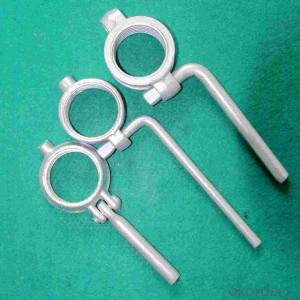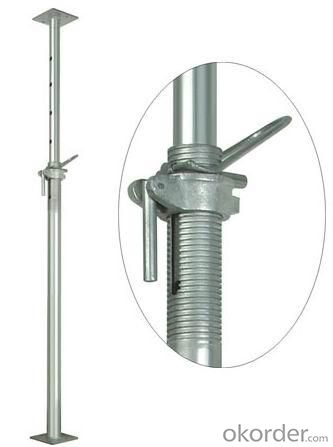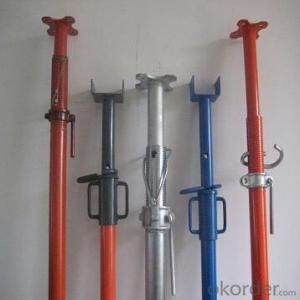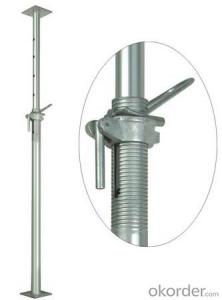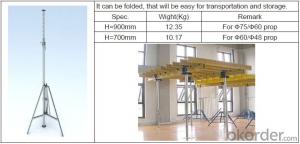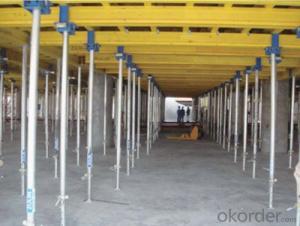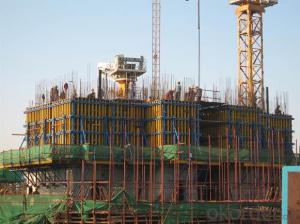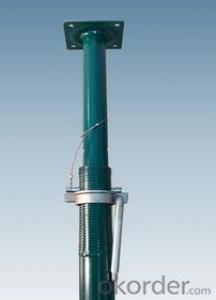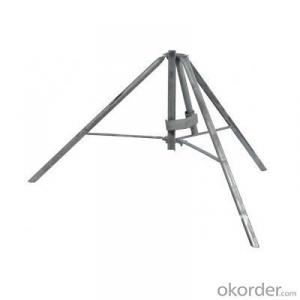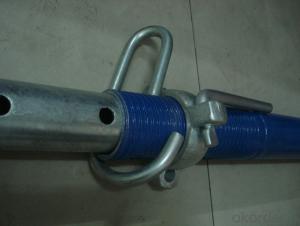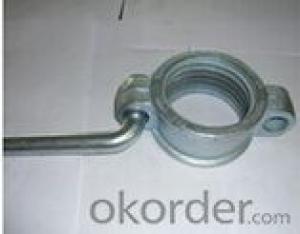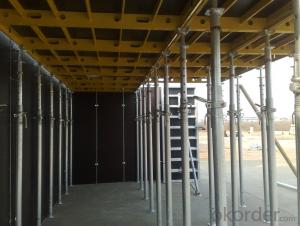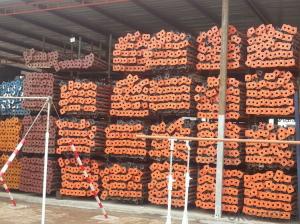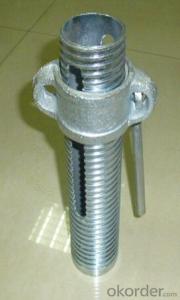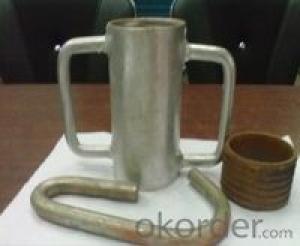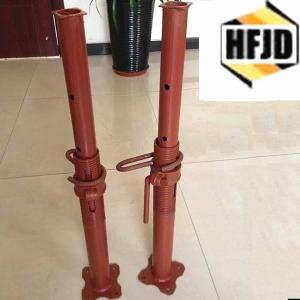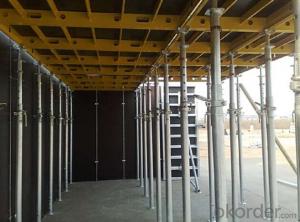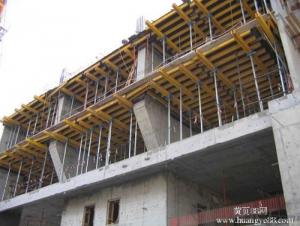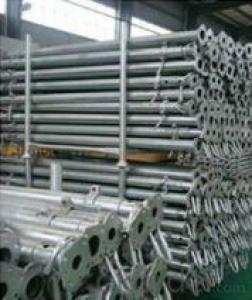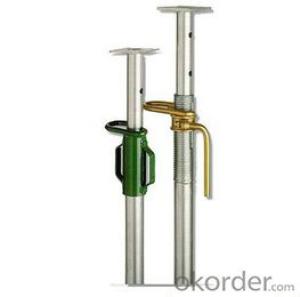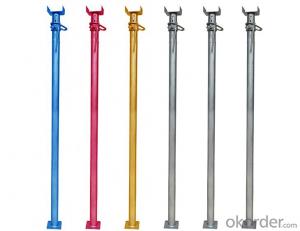steel prop nut Professional pupular new product
- Loading Port:
- Tianjin
- Payment Terms:
- TT OR LC
- Min Order Qty:
- 1 m.t.
- Supply Capability:
- 10000 m.t./month
OKorder Service Pledge
OKorder Financial Service
You Might Also Like
Professional qualified produce frame scaffolding props
Types of Shoring Props
We produce different kinds of steel props, post shore, shoring props, slab props, floor props, U head props for all range floor formwork and slab formworks, covering nearly all light and heavy construction requirements, surface treatment can be painting, powder coating, electro galvanized, and hot dip galvanized.
We also produce high quality European slab props according to EN1065 standard, durable, hot dip galvanised treated, made from high quality solid steel, safety catch design and cost efficient.






Packing



Our Company

Introduction
CNBM Metal International Corporation was found in 1984. It is a professional manufacturer of
casting parts for industrial, formwork and scaffolding field. There are altogether 300
employees including 43 technicians and 10 senior engineers. The weight of each casting part
ranges from 0.1kg to 10 tons. The products are extensively used on construction machinery,
building equipment, formwork and scaffolding. The products are mainly exported to foreign
countries like Europe, America, Great Britain, Canada, Japan, Middle East, etc.
Enterprise Development
1, To decide the product structure according to the market equipment
Basic strategy: To develop casting and punching part steadily for industrial, formwork and
scaffolding and actively expand market in all over the world, and improve the manufacturing
level.
2, continuously improvement is our tenet and customer’s satisfaction is our goal.
Continuously improvement is the method for persistent progress, focusing on details is the
way of process control, and exceeding the customer’s expectation is our eternal pursuit.
3, Continuous development
To develop, enlarge and strengthen is the basis of enhancing market competitiveness and
basic on human oriented to strength teamwork, improve management level, insist on steady
and continuous development is the tenet of achieving the “ A century company”.



Quality Inspection
In regard to meet the quality requirement, our testing lab is established with different kind of
material inspection equipment, the inspectors are trained with professional inspecting
knowledge and working experience at site. The testing report for each shipment is properly
recorded and convenient for customer and our chief engineer to check out and track
according specified shipment.

tag: steel prop nut
- Q: How do you ensure the stability of a steel prop on loose gravel?
- To ensure the stability of a steel prop on loose gravel, one can take several measures: 1. Opt for an appropriate prop design: Select a steel prop specifically designed for use on unstable surfaces. Look for props with wide bases or adjustable feet that offer improved stability on loose gravel. 2. Utilize a larger base plate: If the prop allows for it, consider using a larger base plate to distribute the prop's weight over a wider area. This can prevent the prop from sinking into the loose gravel and enhance stability. 3. Ensure correct installation: Follow the manufacturer's instructions to install the prop accurately. This may involve securely anchoring the base plate to the ground or employing additional support structures like stakes or braces to prevent tipping or shifting on the loose gravel. 4. Regularly check stability: Regularly inspect the prop to ensure it remains stable and secure. This is crucial on loose gravel as ground conditions can change over time. If any signs of instability or shifting are detected, take immediate action to reinforce the prop or adjust its position. 5. Consider extra support: Depending on specific requirements and conditions, additional support may be necessary. Braces, ties, or other stabilizing methods can be used to secure the prop to nearby structures or objects, thereby enhancing stability and preventing movement on the loose gravel. Prioritizing safety when handling steel props on loose gravel is essential. If uncertain about stability or safety measures, consulting a structural engineer or experienced professional can offer valuable guidance and ensure proper stability is achieved.
- Q: What are the alternatives to steel props?
- There are several alternatives to steel props that can be used for supporting structures during construction or renovation projects. Some of these alternatives include: 1. Aluminum props: Aluminum props are lightweight and provide a high strength-to-weight ratio. They are easy to handle and transport, making them a popular choice for temporary support in construction projects. Additionally, aluminum props are resistant to corrosion, which makes them suitable for use in humid or coastal areas. 2. Timber props: Timber props, also known as wooden props, are a traditional and cost-effective alternative to steel props. They are commonly made from high-quality timber, such as hardwood, and can be easily adjusted to the required height. Timber props are lightweight, easy to handle, and can be used for various construction applications. 3. Adjustable telescopic props: Telescopic props are made from materials like aluminum or fiberglass and feature an adjustable length mechanism. They can be easily extended or retracted to fit the desired height and provide support for different types of structures. These props are commonly used in applications where variable heights are required or where space is limited. 4. Hydraulic jacks: Hydraulic jacks are another alternative to steel props and are often used for heavy-duty applications. These jacks use hydraulic pressure to raise and support heavy loads. They are commonly used in industrial settings or for lifting and supporting structures like bridges or buildings during construction or maintenance. 5. Screw jacks: Screw jacks are mechanical devices that use a threaded rod and a nut to provide support. They can be adjusted to the desired height by rotating the rod, allowing for precise leveling and support. Screw jacks are commonly used in applications where a stable and adjustable support system is required, such as in temporary structures or formwork. It is important to consider the specific requirements of the project and consult with a structural engineer or construction professional to determine the most suitable alternative to steel props based on factors such as load-bearing capacity, durability, and cost-effectiveness.
- Q: Are steel props suitable for both residential and commercial projects?
- Yes, steel props are suitable for both residential and commercial projects. Steel props, also known as adjustable steel props or telescopic steel props, are widely used in construction projects to provide temporary support to walls, ceilings, beams, and other structural elements. They are highly versatile and can be adjusted to different heights, making them suitable for a wide range of applications. In residential projects, steel props are commonly used during renovations or remodeling processes. They provide support to walls or ceilings that may need to be temporarily removed or altered. Steel props are also useful in supporting load-bearing walls during repairs or additions to ensure the structural integrity of the building. In commercial projects, steel props play a crucial role in providing temporary support during the construction of multi-story buildings. They are used to support concrete slabs, beams, and other heavy elements until the permanent structural components are in place. Steel props are particularly beneficial in high-rise construction projects where the loads are significant and require reliable temporary support. Steel props offer several advantages that make them suitable for both residential and commercial projects. They are made of durable steel, which provides high load-bearing capacity and stability. They are adjustable, allowing for precise height adjustments to accommodate various project requirements. Additionally, they are easy to install, dismantle, and transport, making them convenient for use in different construction sites. Overall, steel props are a reliable and versatile solution for temporary support in both residential and commercial projects. Their strength, adjustability, and ease of use make them suitable for a wide range of construction applications, ensuring the safety and stability of the structures being built or renovated.
- Q: What are the common signs of wear and tear in steel props?
- The signs of wear and tear in steel props can differ based on their specific use and conditions. However, there are some common indications to look out for: 1. Surface corrosion: Moisture and environmental conditions can cause rust spots or discoloration on the steel surface. 2. Deformation: Heavy loads, improper storage, or accidental impacts can lead to bending, warping, or buckling of the steel structure. 3. Cracks or fractures: Excessive weight or prolonged use may result in cracks or fractures on the main structural elements or at the joints. 4. Loose or damaged nuts and bolts: The fasteners connecting various components can become loose, damaged, or stripped, affecting stability and safety. 5. Increased movement or instability: Wear and tear can cause wobbling or shaking during use, compromising the structural integrity. 6. Reduced load-bearing capacity: Material fatigue, corrosion, or other forms of damage can decrease the prop's ability to support the intended load or cause visible signs of stress. 7. Deterioration of protective coatings: Peeling, cracking, or chipping of the protective coatings may occur over time. Regular inspections are crucial to ensure the continued safety and performance of steel props. If any of these signs are noticed, appropriate measures such as repairs, replacements, or strengthening should be taken.
- Q: Are steel props adjustable in both inclination and declination?
- No, steel props are not adjustable in both inclination and declination.
- Q: How do you secure a steel prop in place?
- To secure a steel prop in place, you can follow these steps: 1. Position the steel prop: Place the steel prop in the desired location where it will provide support. 2. Adjust the prop height: Extend or retract the prop's telescopic sections to achieve the required height. 3. Tighten the locking mechanism: Once the prop is at the desired height, lock the telescopic sections in place using the prop's locking mechanism. This will prevent the prop from collapsing or shifting. 4. Secure the base: Ensure the prop's base is placed on a stable and level surface. If necessary, use shims or wedges to stabilize the base. 5. Provide additional support: Depending on the application, you may need to secure the prop further by attaching it to adjacent structures, using braces, or tying it off to ensure stability and prevent accidental movement. 6. Regularly inspect and maintain: Periodically check the prop's condition, especially during extended use, and tighten or adjust as needed to maintain its security. By following these steps, you can effectively secure a steel prop in place, providing reliable support and ensuring safety.
- Q: What are the common maintenance requirements for steel props?
- The common maintenance requirements for steel props include regular cleaning, inspection, lubrication, and storage. Cleaning is essential to remove dirt, debris, and any corrosive substances that may have accumulated on the props. This can be done using a mild detergent and water solution, followed by thorough drying to prevent the formation of rust. Inspection should be carried out periodically to check for any signs of damage or wear. This includes examining the prop for cracks, bends, or loose components. If any issues are detected, the prop should be repaired or replaced to ensure its safe and effective use. Lubrication is necessary to keep the prop functioning smoothly. Applying a suitable lubricant to moving parts, such as the adjustable mechanisms, will help reduce friction and prevent premature wear. Proper storage is crucial to maintaining the integrity of steel props. They should be stored in a dry and well-ventilated area, away from moisture and direct sunlight. It is also important to keep them properly stacked or secured to prevent accidental damage. In addition to these maintenance requirements, it is advisable to follow the manufacturer's guidelines and recommendations for specific maintenance procedures. Regular maintenance will not only extend the lifespan of the steel props but also ensure their safe and efficient operation.
- Q: What is the maximum height that can be achieved with steel props?
- The height that can be reached with steel props depends on various factors. These include the props' load capacity, the stability and strength of the supporting structure, and the specific application or construction project. Steel props, also known as adjustable steel props or scaffolding props, are commonly used in construction to provide support for temporary structures, formwork, or scaffolding systems. Steel props are available in different sizes and load capacities, ranging from a few hundred kilograms to several tonnes. The maximum height of the props is determined by their load capacity. It is important not to exceed the recommended load capacity as this could compromise the safety and stability of the structure. Therefore, it is advisable to consult the manufacturer's specifications or seek guidance from a structural engineer to determine the maximum height that can be achieved with a particular type of steel prop. The stability and strength of the supporting structure are also crucial in determining the maximum height that can be reached. Factors such as wind, soil conditions, and the weight and distribution of the load being supported can affect the stability of the structure. It is essential to consider these factors and ensure that the supporting structure is designed and constructed to withstand the intended load and height requirements. Furthermore, the specific application or construction project will also impact the maximum height achievable with steel props. For example, if the props are being used to support formwork for a concrete slab, the height may be limited by the pouring and curing requirements of the concrete. On the other hand, if the props are used for temporary scaffolding, the height may be regulated by industry standards and safety regulations. In conclusion, the maximum height that can be achieved with steel props depends on factors such as the props' load capacity, the stability and strength of the supporting structure, and the specific application or construction project. It is important to consult the manufacturer's specifications and seek professional guidance to ensure the safe and efficient use of steel props in any construction project.
- Q: Can steel props be used on uneven surfaces?
- Yes, steel props can be used on uneven surfaces. Steel props are adjustable and can be extended or shortened to fit various heights and angles. This flexibility allows them to be used on uneven surfaces by adjusting the length of the props accordingly.
- Q: Can steel props be used in underground mining tunnel construction?
- Yes, steel props can be used in underground mining tunnel construction. Steel props are commonly used to support the roof and walls of tunnels, providing stability and ensuring the safety of workers. They are durable, strong, and can withstand the challenging conditions of underground mining operations.
Send your message to us
steel prop nut Professional pupular new product
- Loading Port:
- Tianjin
- Payment Terms:
- TT OR LC
- Min Order Qty:
- 1 m.t.
- Supply Capability:
- 10000 m.t./month
OKorder Service Pledge
OKorder Financial Service
Similar products
Hot products
Hot Searches
Related keywords
